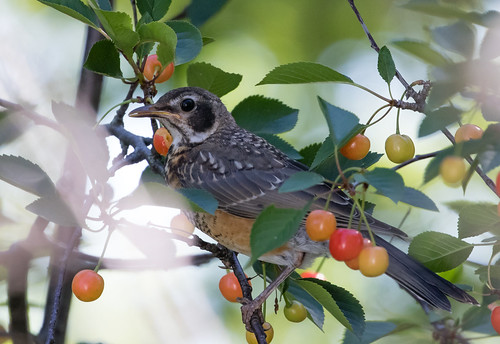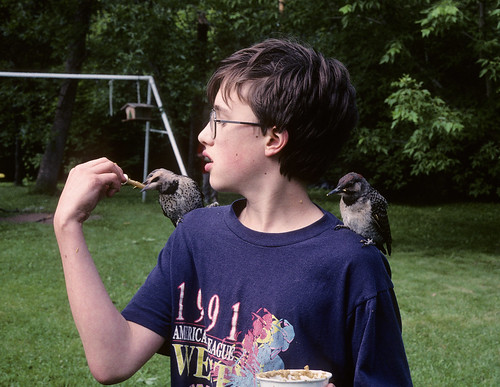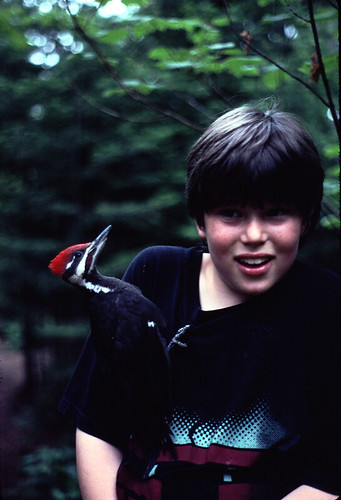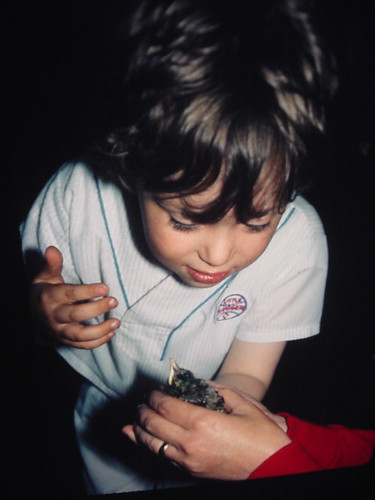 |
| My son Tommy learns about the miracle of baby bird life as we PROPERLY cared for baby birds, when I was a licensed bird rehabber. |
She’d been feeding them nothing but canned dog food and didn’t know how to feed them properly, or keep them in a clean environment, so all four were caked in a disgusting mixture of dried up food and feces. I had to bathe them repeatedly over many hours to even be able to identify them. They were Red-eyed Vireos. Their little bodies, including their heads and, in one case, their eyes, had been so completely encased in crusted filth for so many days that they literally could not grow.
She brought them to me just before the Fourth of July weekend, because she was expecting company and also, she confided, because she did not want her children to experience the sadness of them dying. She drove off feeling virtuous for saving her children from that. I’m sure when she got home she told them that the birds were being taken care of and would all fly off happily.
Meanwhile, my children and I were the ones left to experience the sadness of death. The tiniest nestling lasted barely a day, but all of them were beyond the point of no return when I got them.
They’d not received vitamins or other essential elements of their diets to ensure proper bone development. The people must have been feeding the chicks chunks of dog food that were much too large to be swallowed. The poor things’ heads were so encrusted that their brains had not been allowed to grow properly. They were kept on flat paper towels that were not changed frequently enough.
In nature, their parents would have collected the fecal sacs the moment they were produced. Baby birds poop almost immediately after swallowing while the parent who fed it is sure to still be present. That makes that part of taking care of baby birds easy for people, too. The back end of two of these nestlings was so encrusted that their droppings couldn’t get out of their bodies. I still shudder remembering this, and have mercifully forgotten a lot of other details. In the end, none of them made it. My children were heartbroken.
A biblical maxim says that man cannot live by bread alone. The metaphor is not about the need for balanced nutrition—it’s about how human beings cannot thrive when only the needs of their stomachs are addressed. Keeping baby birds clean and comfortable is as essential as food. Also, from the moment baby birds hatch, they are learning about their world and interacting with it. Many baby birds of migratory species, days or a week before they even leave the nest, start to learn star patterns. They’ll use the one fixed star in the sky, Polaris, as a compass point when they take off for the tropics.
They practice preening as their itchy new feathers emerge. They’ll learn how to aim and peck at things by practicing on nest materials. They’ll start recognizing their parents by sound as well as visually, and many will start learning the vocalizations of their species while they’re still in the nest. During the nestling stage, baby birds are not just tiny eating and pooping machines. They’re soaking in information about the world around them just as human babies are during the language acquisition stage.
This is why people are so cautioned to return baby birds to their nest if at all possible. And why, when brought a baby bird, rehabbers do their darnedest to get it in the nest of a wild bird of the same species with chicks at the same point in development, as long as the wild nest doesn't have a full brood, so the parents won't be overtaxed.
It’s so frustrating to me that so many people who think they’re rescuing baby birds get entirely focused on feeding. It reminds me of orphanages in the 1800s where babies were kept in cribs with virtually no human contact except for feeding and diaper changing. And once baby birds leave the nest, the hard work is just beginning.
The more I’ve observed and learned about birds, the more I’ve learned just how much parent birds give their young than just food. We humans seem to think an education involves either housebreaking and training a puppy, or providing far more esoteric learning to young humans. Many people still believe that birds are little more than feathered robots performing preprogrammed behaviors that were wired in them before they even hatched, despite hundreds, probably thousands, of studies to the contrary.
Scientists have shown how critical parental guidance is in a huge number of ways. In just the single example of vocalizations, parent birds often help their young master the vocalizations that will be essential in recognizing and alerting others to danger, sticking with the parents through migration, finding food, settling in with feeding flocks, attracting a mate, and other functions. Not all species have the same communications needs. That depends on a lot of factors in their life histories, and each species is unique.
For example, two pretty similar species, the Bank and Northern Rough-winged Swallows, learn vocalizations differently. Northern Rough-winged Swallow parents do not provide care for any nestlings of other species, but after their own young fledge, they’ll feed any begging rough-winged fledglings that they encounter. This is not a problem, because rough-wings are usually fairly territorial, and so are unlikely to encounter other rough-wings begging. Bank Swallow parents quickly learn the calls of their own nestlings even as their chicks are learning their parents’ calls. Bank Swallows nest in large colonies, and the young mingle together after fledging. By recognizing their own families’ unique voices, Bank Swallow families can keep track of each other, increasing the chances of each pair’s own young reaching independence.
But this does not hold true of every species that gathers in flocks. Evening Grosbeak flocks start mingling as soon as young fledge, but in this species, any adult will feed any chicks, related or not.
In their real world, robins hop about, mostly hiding out in shrubs for a few days after they leave the nest. The fledglings exercise their wings and learn a lot from their parents and from observing the world. They’re clumsy at first, but get great at negotiating branches while they’re still flittering about, rather than flying at full speed. Their parents teach them to avoid dogs and other potential predators, and to keep their distance from people. And in the world of robins, when a brood fledges, both parents continue to feed them even as the mother starts producing a new clutch of eggs. The young watch each other and learn from each other’s mistakes as well as successes. When the new clutch of eggs is complete and the mother starts incubating them, the father continues to feed and teach the fledglings. Every evening he leads them to a roosting spot. They learn many skills from him but are growing increasingly independent, and starting to associate with other young robins. By the time the new batch of eggs hatches and the male must start raising them, this first batch of young is ready to be on their own. When people raise a baby robin indoors and release it in a park after it can fly, that poor defenseless bird will be negotiating the world pretty much as helplessly as a sheltered, home-schooled ten-year-old would if his parents suddenly released him downtown and expected him to take care of himself for good.
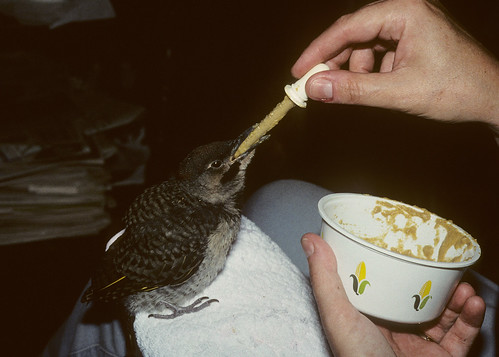 |
| When we raised baby flickers, we knew they could be indoors only until they took their first flight. Even as new fledglings, woodpecker wingbeats are too strong to keep in confined spaces at all. |
